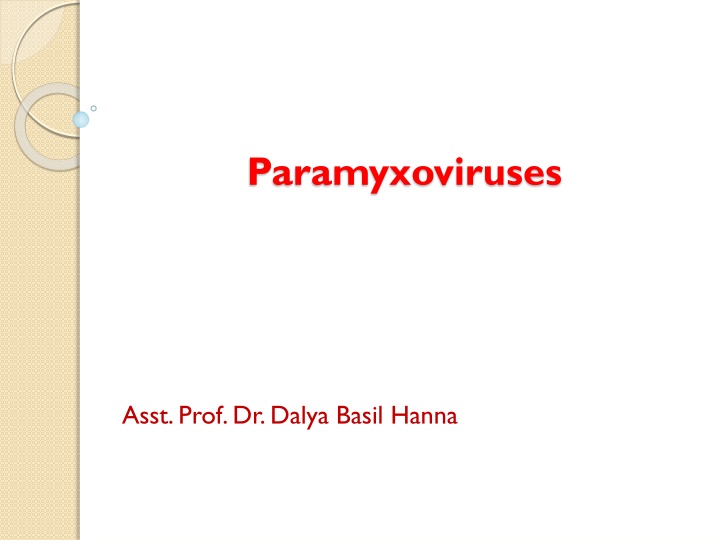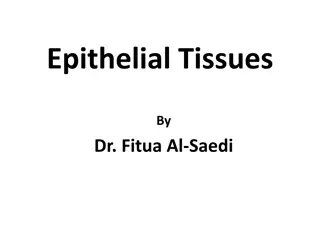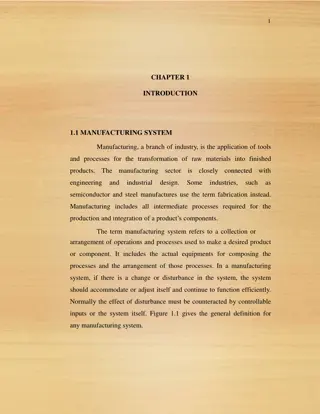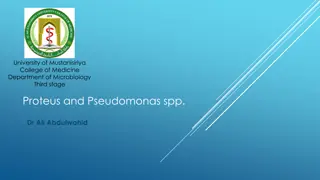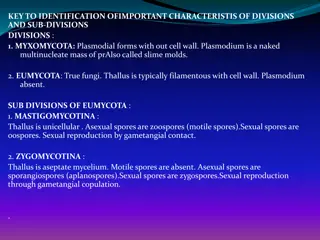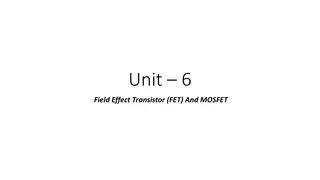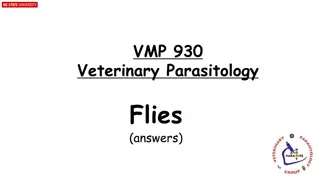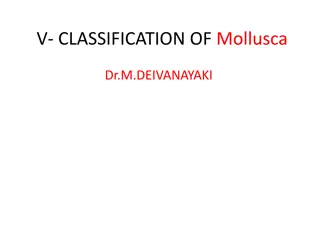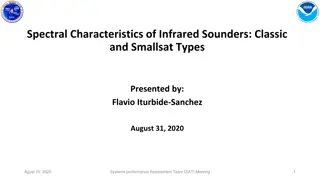Overview of Paramyxoviruses and Their Characteristics
Paramyxoviruses, including members like measles and mumps viruses, initiate infections through the respiratory tract. They have unique properties such as a pleomorphic structure, RNA composition, and antigenic stability. Understanding their replication process and host cell interactions is crucial in combating diseases caused by these viruses. Gain insights into the world of Paramyxoviruses and their impact on human health.
Uploaded on Mar 03, 2025 | 1 Views
Download Presentation

Please find below an Image/Link to download the presentation.
The content on the website is provided AS IS for your information and personal use only. It may not be sold, licensed, or shared on other websites without obtaining consent from the author.If you encounter any issues during the download, it is possible that the publisher has removed the file from their server.
You are allowed to download the files provided on this website for personal or commercial use, subject to the condition that they are used lawfully. All files are the property of their respective owners.
The content on the website is provided AS IS for your information and personal use only. It may not be sold, licensed, or shared on other websites without obtaining consent from the author.
E N D
Presentation Transcript
Paramyxoviruses Asst. Prof. Dr. Dalya Basil Hanna
Paramyxoviridae a. Measles rubeola b. Mumps c. Parainfluenza d. RSV respiratory syncytial virus
Paramyxoviruses All members of the Paramyxoviridae family initiate infection via the respiratory tract. Replication pathogens is limited to the respiratory epithelia, whereas become disseminated throughout the body and produce generalized disease. The morphology of Paramyxoviridae is pleomorphic, with particles 150 nm or more in diameter, occasionally ranging up to 700 nm. of the respiratory measles and mumps
Properties of Paramyxoviruses Virion: Spherical, pleomorphic, 150 nm or more in diameter (helical nucleocapsid,13 18 nm) Composition: RNA (1%), protein (73%), lipid (20%), carbohydrate (6%) Genome: Single-stranded negative RNA, linear, nonsegmented, about 15 kb Proteins: Six to eight structural proteins Envelope: Contains viral glycoprotein (G, H, or HN) (which sometimes carries hemagglutinin or neuraminidase activity) and fusion (F) glycoprotein Replication: Cytoplasm;particles bud from plasma membrane Outstanding characteristics: Antigenically stable Particles are labile yet highly infectious
Paramyxovirus Replication Attachment, Penetration, & Uncoating Paramyxoviruses attach to host cells via the hemagglutinin glycoprotein (HN,H, or G protein). Next, the virion envelope fuses with the cell membrane by the action of the fusion glycoprotein. If the F precursor is not cleaved, it has no fusion activity; virion penetration occur; and the virus particle is unable to initiate infection. does not
Transcription, Translation, & RNA Replication Messenger RNA transcripts are made in the cell cytoplasm by the viral RNA polymerase, and synthesized in the cytoplasm. viral proteins are Maturation The virus matures by budding from the cell surface. Progeny nucleocapsids form in the cytoplasm and migrate to the cell surface.
Measles (Rubeola) Virus Infections Measles is an acute, highly infectious disease characterized by fever, respiratory symptoms, and a maculopapular rash. Complications are common and may be quite serious. The introduction of an effective live-virus vaccine has dramatically reduced the incidence of this disease.
Pathogenesis & Pathology Humans are the only natural hosts for measles virus. The virus gains access to the human body via the respiratory multiplies locally; spreads to the regional lymphoid tissue, where further multiplication Primary viremia disseminates the virus. tract, infection where it the then occurs.
Pathogenesis & Pathology Finally, a secondary viremia seeds the epithelial surfaces of the body, including the skin,respiratory tract,and conjunctiva, where focal replication occurs. Measles can replicate in certain lymphocytes, which aids in dissemination throughout the body.
Pathogenesis & Pathology The described events occur during the incubation period, which typically lasts 8 12 days but may last up to 3 weeks in adults. Involvement of the system is common in measles. Because infectious virus is rarely recovered from the brain, it has been suggested that an autoimmune reaction is the mechanism responsible for this complication. central nervous
Clinical Findings Infections in nonimmune hosts are almost always symptomatic. After an incubation period of 8 12 days, measles is typically a 7-11days illness (with a prodromal phase of 2 4 days followed by an eruptive phase of 5 8 days). The prodromal phase is characterized by fever, sneezing, coughing, running nose, redness of the eyes, Koplik spots, and lymphopenia. The cough and coryza reflect an intense inflammatory reaction involving the mucosa of the respiratory tract. The conjunctivitis is commonly associated with photophobia.
Clinical Findings Koplik spots are small, bluish-white on the buccal mucosa opposite molars. These contain giant cells and viral antigens and appear about 2 days before the rash.The fever and cough persist until appears and then subside within 1 2 days. ulcerations the lower spots the rash
Clinical Findings The measles is otitis media (5 9% of cases). Pneumonia is the most common life- threatening complication caused by secondary bacterial infections. Pulmonary complications more than 90% of measles-related deaths. Pneumonia develops in 3 15% of adults with measles, but most cases are due to the virus itself rather than bacteria. most common complication of of measles, account for
Laboratory Diagnosis Antigen & NucleicAcid Detection Measles antigens can be detected directly in epithelial cells from respiratory secretions, the nasopharynx, conjunctiva, and urine. Antibodies to the nucleoprotein are useful because that is the most abundant viral protein in infected cells. Detection of viral RNA by RT-PCR is a sensitive method that can be applied to a variety of clinical diagnosis. samples for measles
Laboratory Diagnosis Isolation & Identification ofVirus Nasopharyngeal blood samples, respiratory secretions, and urine collected from a patient during the febrile period are appropriate sources for viral isolation. Serology Serologic confirmation of measles infection depends on a fourfold rise in antibody titer between acute-phase phase and conjunctival swabs, and convalescent-
Treatment, Prevention, & Control Measles virus is susceptible in vitro to inhibition by ribavirin, but clinical benefits have not been proved. A highly effective and safe attenuated live measles virus vaccine has been available since 1963.
Treatment, Prevention, & Control It is recommended that all children, health care workers, and international travelers be vaccinated. Contraindications to vaccination include pregnancy, immune (except that due to infection with human immunodeficiency virus). The use of killed measles virus vaccine was discontinued by 1970, as certain vaccinees became sensitized and developed severe atypical measles when infected with wild virus. compromise
Mumps Virus Infections Mumps is an acute contagious disease characterized by enlargement of one or both salivary glands. Mumps virus mostly causes a mild childhood disease, complications including meningitis and orchitis are fairly common. More than one-third of all mumps infections are asymptomatic. nonsuppurative but in adults
Pathogenesis & Pathology Humans are the only natural hosts for mumps virus.Primary replication occurs in nasal or upper respiratory tract epithelial cells. Viremia then disseminates the virus to the salivary glands and other major organ systems. Involvement of the parotid gland is not an obligatory step in the infectious process. The incubation period may range from 2 to 4 weeks but is typically about 14 18 days. Virus is shed in the saliva from about 3 days before to 9 days after the onset of salivary gland swelling.
Pathogenesis & Pathology About one-third of infected individuals do not exhibit obvious symptoms (inapparent infections) but are equally capable of transmitting infection. It is difficult to control transmission of mumps because of the variable incubation periods, the presence of virus in saliva before clinical symptoms develop, and the large number of asymptomatic but infectious cases. Mumps is a systemic viral disease with a propensity to replicate in epithelial cells in various visceral organs.Virus frequently infects the kidneys and can be detected in the urine of most patients. Viruria may persist for up to 14 days after the onset of clinical symptoms. The central nervous system is also commonly infected and may be involved in the absence of parotitis.
Clinical Findings The clinical features of mumps reflect pathogenesis infection. At least one- third of infections are subclinical, including the majority of infections under 2 years of age. cases is swelling of the salivary glands, which The most characteristic symptomatic about 50% of patients. the the of all mumps in children feature occurs of in
Clinical Findings Central common (10 30% of cases). The testes and ovaries may be affected, especially after puberty. Twenty to fifty percent of men who are infected with mumps virus develop unilateral).Because of the lack of elasticity of the tunica albuginea, which does not allow the inflamed testis to swell, the complication is extremely painful. Atrophy of the testis may occur as a result of pressure necrosis, but only rarely does sterility result. nervous system involvement is orchitis (often
Laboratory Diagnosis Isolation & Identification of Virus The most appropriate clinical samples for viral isolation are saliva, cerebrospinal fluid, and urine collected within a few days after onset of illness. Virus can be recovered from the urine for up to 2 weeks. Nucleic Acid Detection RT-PCR is a very sensitive method that can detect mumps genome sequences in clinical samples. It can detect the virus in many clinical samples that are negative in virus isolation attempts.
Laboratory Diagnosis Serology Simple detection of mumps antibody is not adequate to diagnose an infection. Rather, an antibody rise can be demonstrated using paired sera: a fourfold or greater rise in antibody titer is evidence of mumps infection. The ELISA or HI test is commonly used. Antibodies against the HN protein are neutralizing. ELISA can be designed to detect either mumps-specific IgM antibody or mumps-specific IgG antibody. Mumps IgM is uniformly present early in the illness and seldom persists longer than 60 days. Therefore, demonstration of mumps- specific IgM in serum drawn early in illness strongly suggests recent infection. Heterotypic parainfluenza virus infections do not cross-react in the mumps IgM ELISA. antibodies induced by
Treatment, Prevention, & Control There is no specific therapy. Immunization with attenuated live mumps virus vaccine is the best approach to reducing mumps- associated morbidity and mortality rates. Attempts to minimize viral spread during an outbreak by using isolation procedures are futile because of the high incidence of asymptomatic cases and the degree of viral shedding before clinical symptoms appear; however, students and health care workers who acquire mumps illness should be excluded from school and work until 5 days after the onset of parotitis.
Treatment, Prevention, & Control An effective attenuated live-virus vaccine made in chick embryo cell culture was licensed in the United States in 1967. It produces a subclinical, noncommunicable infection. Mumps vaccine is available in combination with measles and rubella (MMR) live-virus vaccines. Combination live-virus vaccines produce antibodies to each of the viruses in about 78 95% of vaccinees. There is no increased risk of aseptic meningitis after MMR vaccination. Other live attenuated mumps virus vaccines have been developed in Japan, Russia, and Switzerland.
Treatment, Prevention, & Control Two recommended for school entry. Because of the 2006 outbreak of mumps, updated vaccination recommendations for prevention of mumps transmission in settings with high risk for spread of infection were released. Two doses of vaccine should be given to health care workers born before 1957 without evidence of mumps immunity, and a second dose of considered for those who had received only a single dose. doses of MMR vaccine are vaccine should be
